The ‘It’s good to talk’ campaign by BT, a global telecommunications company, demonstrated the power of focusing on communication. These carefully chosen words led to an impressive incremental £5bn in sales over the five years it ran, as well as helping to transform their brand perception.1
With regards to optometry, imagine what a difference it could make if the whole practice team were confident and proactive in having effective contact lens conversations with all those who are suitable. Colleagues working on the shop floor are often the first point of contact. A typical introduction may begin by asking a question as simple as: ‘Would you like contact lenses?’
Unfortunately, a ‘no’ response often puts an end to the discussion. This article reviews approaches that are more likely to spark interest in contact lenses, keep the conversation flowing and best respond to any concerns regarding contact lenses to lead to a positive outcome.
Why may a lack of interest in contact lenses?
Polls often report sight as being our most valued sense,2 which naturally may result in apprehension and a guarded approach to eye-related factors including contact lenses. The influence of others in their life, a lack of understanding or simply that contact lenses have not been recommended previously also may be clouding people’s judgements. Indeed, there may be some who have had a negative personal experience, although the majority will successfully be able to return to lens wear.3
How can we best introduce contact lenses?
A good starting point is to go back to basics and establish how contact lenses can support people’s individual lifestyle and visual needs by asking open questions such as those listed table 1, below. Finding a personal motivation and reason to believe is a powerful way to encourage even those averse to contact lenses to continue the discussions further.

Finding out from people about current wear and how it is going by asking, ‘How often do you wear contact lenses?’ may be a gentler initial approach than a direct yes/no conversation killer question, revealing any previous wear and encouraging thinking about their current eyewear choices. To build on this further, asking people to imagine a day without needing to wear spectacles, while still being able to see clearly and how this may make them feel may be a powerful thought provoker.
Paraphrasing back and linking to personal information already received can be powerful in influencing their attitudes.
What are the common myths and how can we overcome them?
Careful listening to any concerns followed by a calm reassuring approach is the best way forward to address any misunderstandings. Customer-friendly phrasing to dispel the common myths are provided below.
1 Myth: Contact lenses may not be suitable for my eyes
Suggested response: You’ll be pleased to know that most people can wear contact lenses and you’re more than likely one of them. In fact, there are an estimated 140 million contact lens wearers worldwide, including people of all ages and those with astigmatism.4
The evidence: Publications such as BCLA CLEAR remind us that mass-produced soft lenses will fit 75-90% of eyes and, for those with more irregular eye shape profiles or high prescriptions, there are numerous custom-made options available in a range of different materials.5
Therefore, the reality is that there is only a slim chance of someone not being suitable from a fitting perspective and contraindications would be more likely linked to other factors, for example, eye disease, health or patient-related reasons.
2 Myth: I’m too old/young for contact lenses
Suggested response: It doesn’t matter how old or young you are Ω almost everyone can wear contact lenses. You’ll be amazed at how quickly little ones adapt to them. With 30% of the world’s population aged 45+, there are more multifocal lens options than ever before.6
The evidence: The consensus is that success with contact lenses for children is less dependent on age and more linked to the benefits, ability to be fitted and care for lenses, maturity, motivation and their relative safety in this age group, which appears to be on par with adults.7
The Achieve study concluded that contact lenses significantly improve how children feel about their physical appearance, their acceptance among friends, their ability to play sports and their academic performance.8 This means offering lenses can provide more than just visual benefits to the whole family.
The good news is that children tend to do extremely well with contact lenses and it is nice that researchers have shown that those as young as eight can successfully wear and independently care for their own lenses.9 Studies investigating myopia management more frequently include younger children in their studies. For the very young, contact lenses are usually only considered for medical reasons under the care of a hospital eye service provider.
At the other extreme, given most adults with presbyopia lead active lifestyles, with a desire to feel young at heart, there is no upper age limit for contact lenses. The advancements in optical designs, materials and options available mean multifocal contact lens success rates can be high and are often the preferred option for those with presbyopia.10 Age is just a number and quality of life benefits can be gained by all from wearing contact lenses.
3 Myth: Contact lenses can get lost/stuck behind your eye
Suggested response: It’s physically impossible for a contact lens to get lost or stuck behind your eyes. That’s because there’s a thin membrane that covers the white part of your eye and connects to the inner eyelids. Think of it as a built-in safety net.
The evidence: The eye’s anatomical features (figure 1) make it impossible for lenses to move ‘behind’ the eye, and there have been no large-scale studies of ocular lens retention, although there have been case reports of lenses becoming trapped in the fornix.11-13 Astonishingly for one lady, when her handy eyelid barrier harboured several lenses, awareness of the multiple retained lenses or symptoms did not occur, and they were only discovered when she attended a routine cataract consultation.14 There are reports of conjunctivitis believed to have become manifest secondary to a retained contact lens.13
Figure 1: The anatomy of the eye, with the eyelids providing a barrier to limit lens movement
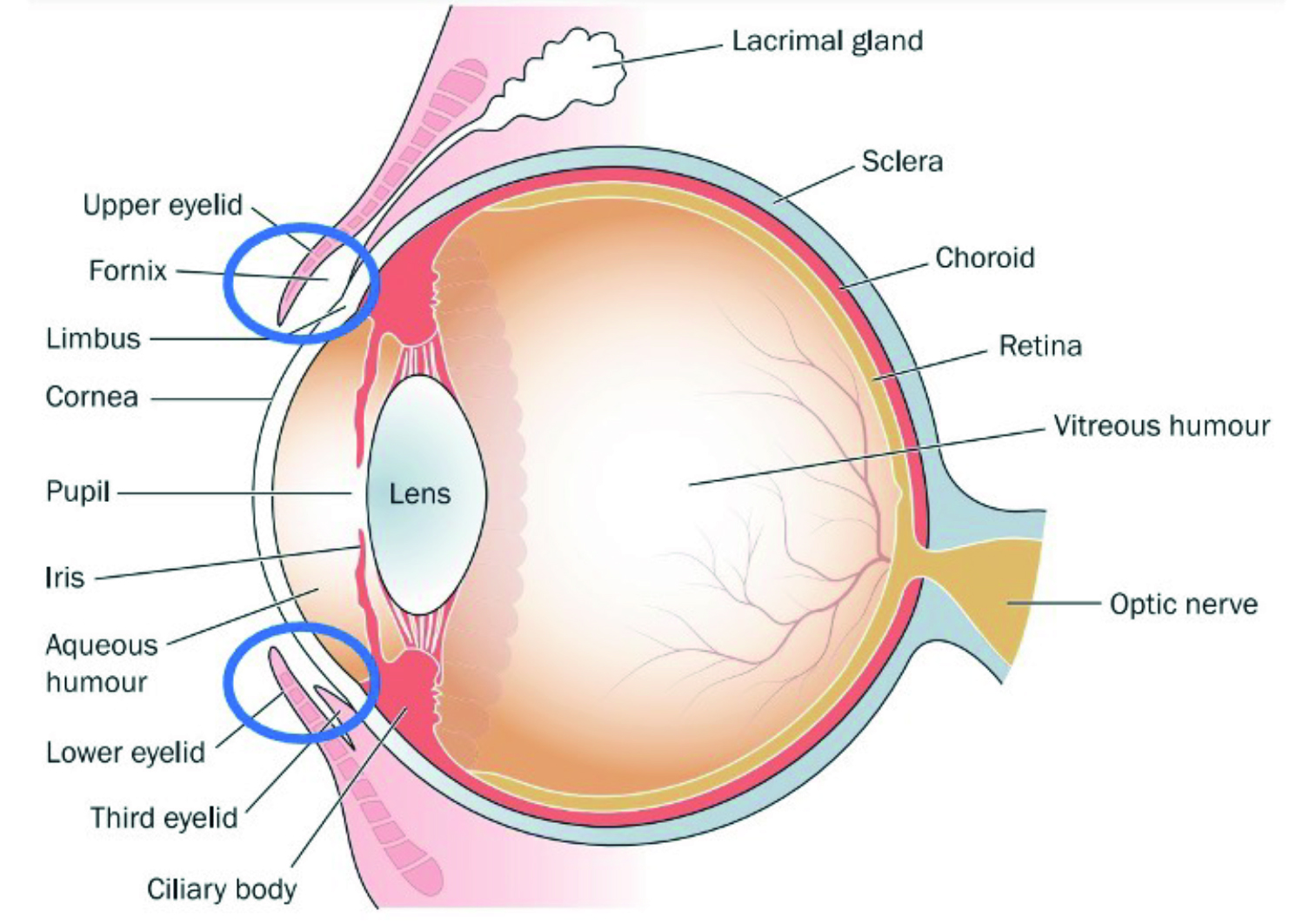
4 Myth: Contact lenses are uncomfortable
Suggested response: You’re about to be pleasantly surprised. Contact lenses are actually one of the most convenient and comfortable eye care solutions. You may even forget you’re wearing them. Think soft, supple, and satisfyingly hydrating.
The evidence: Apart from the testimony of large numbers of loyal happy contact lens wearers, a landmark study compared daily disposable contact lenses, spectacles and non-wearing benchmarks and found no statistically significant difference in terms of comfort or visual quality.15
Comfort in contact lenses is likely to be multifactorial with contact lens, environmental, eye-ocular surface and patient-related factors likely to be associated.16 Regular reviews will enable performance to be maximised, with any signs of sub-optimal performance identified early, allowing for comparisons to be made between comfortable wearing times and actual and desired wearing schedules. Visual quality has also been linked to comfort.
For some, depending on how they define comfort, the potential mechanical restrictions of wearing spectacles may lead them to favour contact lenses. Indeed, in a recent survey, the third most popular reasons for the benefits of contact lenses were the lack of pressure on the nose and ears (figure 2 provides the most common reasons).17
Figure 2: The benefits perceived by contact lens-wearing participants (n=782). Participants were able to choose their top three reasons17
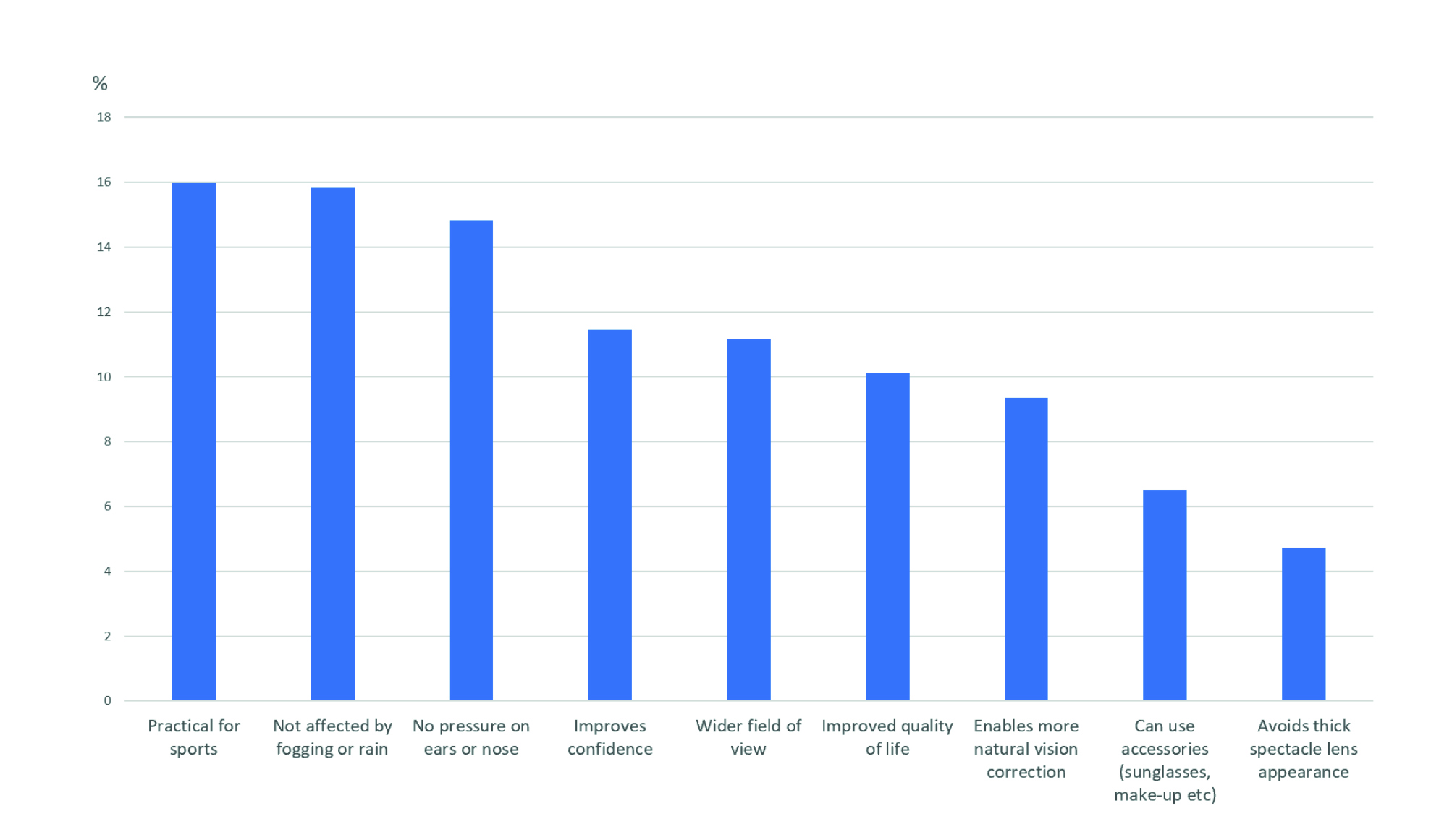
5 Myth: Contact lenses are difficult to apply and remove
Suggested response: Putting in and taking out contact lenses is like riding a bike – you never forget how to do it. You just need to learn the knack, which we can take you through until you’re a pro. Easy.
The evidence: Indeed, a common reason for early dropout is handling-related factors.18 As with any new skill, good education, a supportive approach from the teacher and allocating dedicated time to learn and practice are likely to be key to success.
Follow-up courtesy touch points (for example, a call in the first week) for new wearers may be beneficial and provides the opportunity for coaching on best practice techniques. Addressing the potential for non-compliance and considering the most appropriate lens selection may support better handling. A reminder of the personal benefits of contact lenses linked to their lifestyle activities can often help motivate new wearers throughout the learning process. Explaining the typical process and reassuring that it may take time to learn the new techniques is also advantageous. Understanding the emotional journey can help when relating to the new wearer (figure 3).
Figure 3: Emotional journey for new contact lens wearers while learning how to handle lenses25
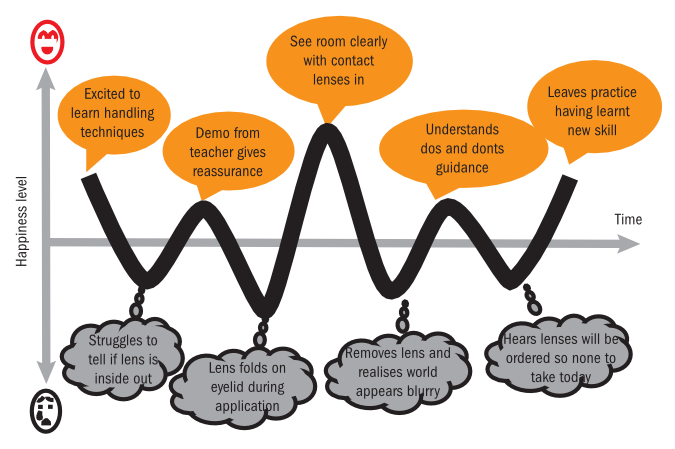
6 Myth: Caring for contact lenses is a hassle
Suggested response: As with all rituals, contact lens care will soon become second nature. Daily disposables are considered the most convenient option, but reusable lenses are simple to clean and store. You’ll soon get used to it.
The evidence: Instilling good habits from the offset is better than a reactive approach to non-compliance so it is well worth setting realistic expectations as to what is required. For soft lenses, daily disposables have been reported to require around half the number of steps to care for than reusable lenses.18 Lenses licensed for overnight wear have convenience advantages, but come with a higher risk of contact lens complications.19
7 Myth: Contact lenses aren’t good for occasional wear
Suggested response: They’re perfect for occasional wear. For all those moments when spectacles get in the way, contact lenses can come to the rescue – whether you’re exercising, socialising or just going about your day. Some people will wear contact lenses every day – the flexibility is there depending on personal choice.
The evidence: One attractive aspect of contact lenses is the ease to dip in and out of wear, often without the need to readapt. With modern soft lenses, the concept of new wearers needing to gradually build up wear time is deemed unnecessary.5 Success is clear with part-time, flexible and full-time wear, depending on what best suits the individual, and even following temporary breaks from lens wear.
8 Myth: Contact lenses are expensive
Suggested response: When you consider the huge benefits of contact lenses, they actually offer fantastic value for money. In fact, per wear they usually cost less than a coffee from your favourite coffee shop.
The evidence: Rather than focusing on the physical cost alone, consider the value of the benefits gained, which makes contact lenses seem a real bargain. ‘Best value for money’ has been defined as the most advantageous combination of cost, quality, and sustainability to meet customer requirements.20 The great advantage of so many contact lenses being commercially available means there are options to suit all budgets and, when considering additional benefits, this may help justify to the consumer higher prices for premium offerings.
Interestingly, although most non-wearers appreciate the visual, practical and emotional benefits (figure 4), they don’t seem to perceive the psychological benefits to the same extent as those who wear contact lenses.25
Figure 4: The benefits of contact lenses25
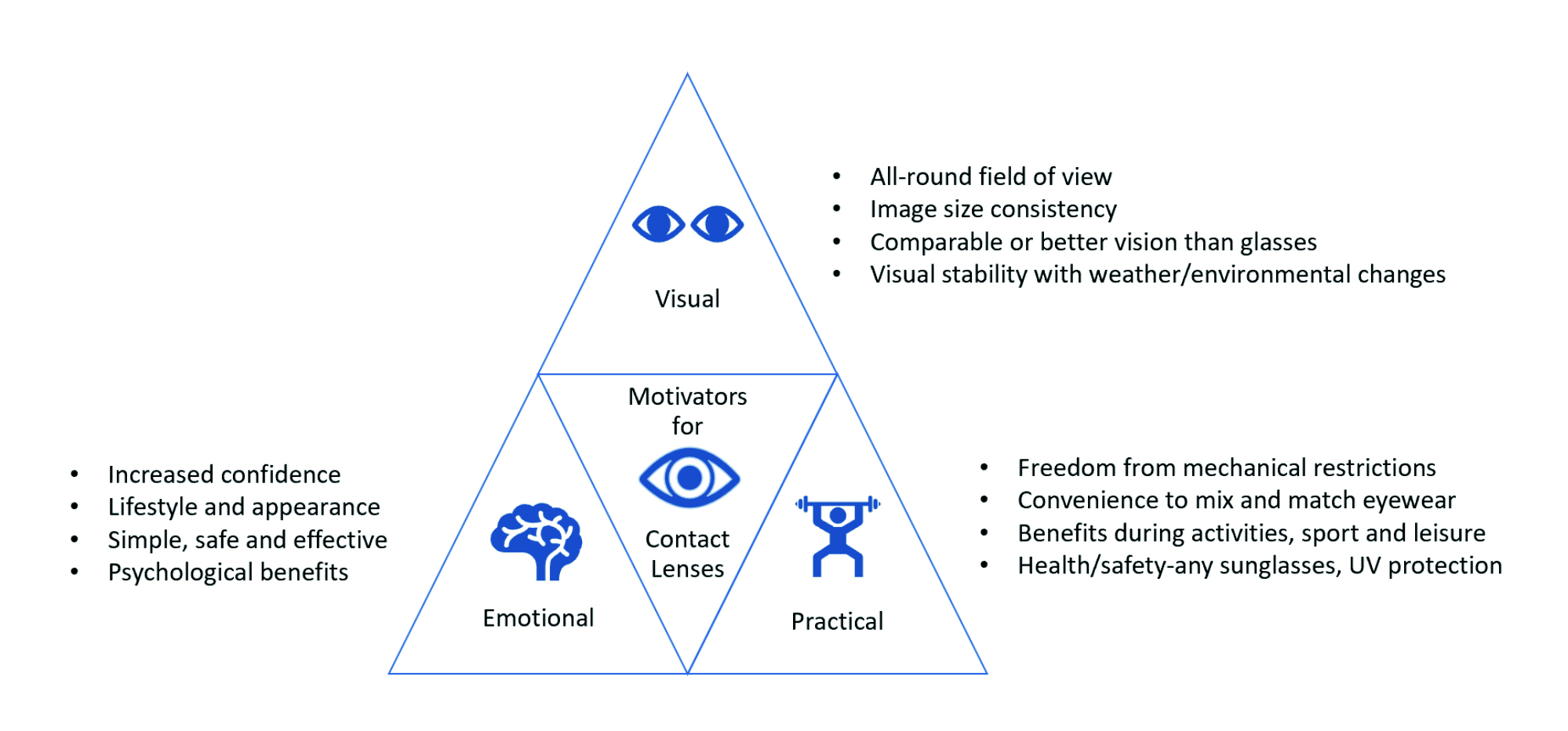
9 Myth: Contact lenses are bad for your eyes
Suggested response: Trust us, your eyes will love contact lenses – you just need to wear and care for them correctly. Let’s talk numbers: only around 1 in 10,000 wearers per year experience contact lens-related infections with daily wear.
The evidence: The risks associated with contact lens wear are low and frequently resolve on removal of the lenses. Corneal infection prevalence ranges from one or two per 10,000 wearers for daily compliant use, to 20 per 10,000 with overnight wear.19 Instilling good compliance principles and a proactive approach helps to minimise risks.
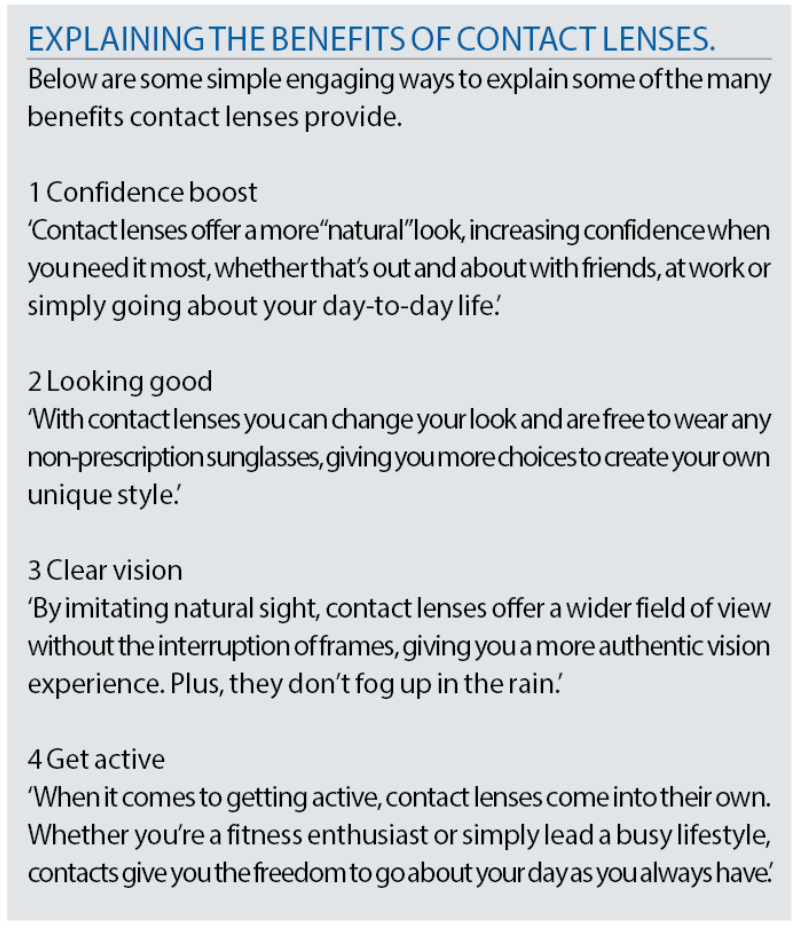
10 Myth: You can wash contact lenses in water
Suggested response: Nope. Unless you want your lenses to be introduced to an organism called Acanthamoeba, which can lead to serious infections, you should never, ever wash your contacts in water. Stick to the contact lens solution.
The evidence: Although Acanthamoeba keratitis is a relatively rare serious eye infection (estimated annual incidence of 1.4 per million per annum), the majority of cases are associated with contact lens wear (71 to 91%).21 As Acanthamoebae are free-living protozoans found in tap water, highlighting that contact lenses and water should not mix is important, as well as correct compliance with hand washing, drying, care systems and any lens storage, lens replacement frequency, shorter wear times (switch to daily wear) and regular reviews to minimise risks. In terms of contact lens-related infections overall, around 80-95% are due to bacteria origins with the small remainder by pathogens, including Acanthamoeba spp and filamentary fungi.19
11 Myth: If I wear glasses, I can’t wear contact lenses
Suggested response: Far from being mutually exclusive, a mixture of spectacles and contact lenses offers many customers the best of both worlds. You get the freedom to choose what to wear depending on what the day’s got in store.
The evidence: Surveys have revealed that having multiple eyewear options increases satisfaction, quality of life and loyalty to the practice. Very few contact lens wearers will solely wear contact lenses and 81% of wearers say that wearing contact lenses and spectacles gives them the best of both worlds.17 They also bring on average 6x more revenue to the practice than non-wearers.22
Introducing contact lenses to support the frame selection process also positively impacts the eyewear selection and purchase experience.23, 24 In fact, the rate of those who then purchase contact lenses increased by 2.5x.24
12 Myth: People who drop out from wearing contact lenses won’t ever wear them again
Suggested response: It seems you can’t have too much of a good thing, because refitting success is reported to be high (>70%), showing that the benefits of contact lenses are simply too good to miss.
The evidence: A review of contact lens dropout research found a pooled mean dropout frequency of 21.7%. On a positive note, most are ‘lapsed wearers’ rather than ‘permanent dropouts’ and around three quarters (74%) of dropouts can successfully resume contact lens wear.3 It's most important for them to revisit what they enjoyed about contact lenses, establish a motivation, and remind them of what they loved about lens wear. Different lenses and additional management advice may be a recommendation to help address their reasons for ceasing lens wear. Also, consideration should be given to supplementary management of any co-existing ocular pathology that could impact upon contact lens performance, such as dry eye. Table 2 has some example questions, which, along with those from table 1, might help someone to reconsider lens wear.
Table 2: Questions for those who previously wore contact lenses
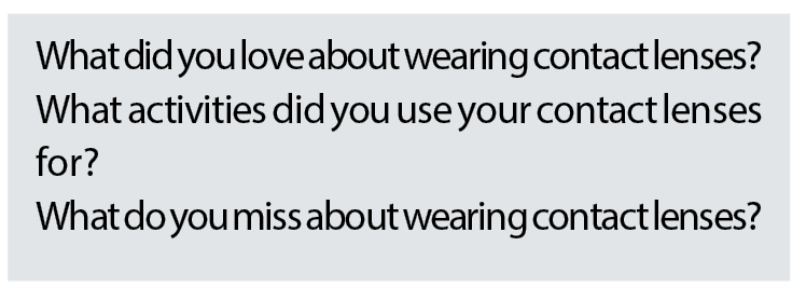
The test of time
Of course, as the wearer ages and their lifestyle changes, the most suitable contact lenses for their needs will also change. Regular reviews will ensure they are always in the best lens for their sight and situation. Useful explorative questions are provided in table 3.
Table 3: Questions to ask to establish most suitable contact lenses
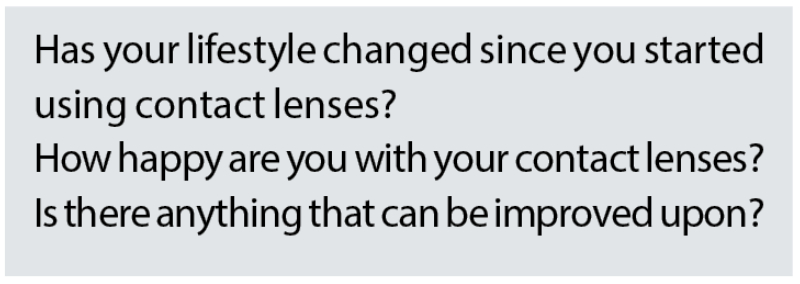
Interestingly, when given the chance to experience new recommendations, even wearers who say they are happy with their current lenses are impressed with the improved performance. A useful benchmark to suggest a need to consider additional management/different lens options is: two hours or more difference between comfortable and total wearing time and/or visual reduction compared to their spectacles. Exploring patient-reported outcomes during specific tasks and seeking rating scores (for example, scores out of 10) for various performance-related aspects are also useful.
Summary
It appears that one of the main barriers to more people wearing contact lenses is the staff in eye care practice. In fact, a recent survey found only one in six recall contact lenses being mentioned during their visit to the opticians. So, the solution is simple. It is time for us and our colleagues to talk about contact lenses at each opportunity along the patient-customer journey.
This can start as early as the booking stage by asking, ‘Shall we book an eye examination and contact lens suitability check?’ followed by reminders of how aspects of their lifestyle could work well with contact lens wear. Finding links to personal motivators and relating to emotional factors is important.26 Remember, people may not respond in the negative forever, so revisiting the conversation at future visits and having awareness resources of the benefits may be advantageous (figure 5). Investing time in contact lens training for the team may be useful (figure 6) as, after all, it is good to talk – about contact lenses.
Figure 5: BCLA contact lens leaflets,27 mirror hanger visibility aids, shop floor video promotions and badges for staff. All resources to help drive awareness

Figure 6: Contact lens training aids for the team including digital learning content and revision cards
- Neil Retallic is the global professional services manager for Menicon and president of the British Contact Lens Association. He is an optometrist and has worked in various clinical, professional services, academic, charity and industry roles across the optical profession.
- Look out for a special issue of Optician focusing on support staff next March.
References
- ‘It’s Good to Talk’ Ω the story behind the campaign (campaignlive.co.uk).
- Enoch J, et al. Evaluating whether sight is the most valued sense. JAMA Ophthalmology, 2019 Nov 1;137(11):p1317-1320.
- Pucker A, Tichenor A. A review of contact lens dropout. Clinical Optometry (Auckl), 2020 Jun 25, 12:p.85-94.
- Jones L, et al. The COVID-19 pandemic: Important considerations for contact lens practitioners. Contact Lens & Anterior Eye, 2020. 43(3): p196-203
- Wolffsohn J, et al. CLEAR - Evidence-based contact lens practice. Contact Lens & Anterior Eye;2021, 44:p368-397
- https://www.gapminder.org/answers/the-rapid-growth-of-the-world-population-when-will-it-slow-down/
- Walsh K, et al. Addressing common myths and misconceptions in soft contact lens practice. Clinical and Experimental Optometry. 2022 Jul;105(5):p459-473.
- Jones-Jordan L, et al. A comparison of spectacle and contact lens wearing times in the ACHIEVE study. Clinical and Experimental Optometry. 2010 May;93(3):157-63.
- Paquette L, et al. Contact lens fitting and training in a child and youth population. Cont Lens Anterior Eye 2015;38:p419-423
- Richdale K, et al. CLEAR Ω Contact lens optics. Contact Lens & Anterior Eye; 2021, 44,p220-239,
- Agarwal P et al. Retained soft contact lens masquerading as a chalazion: a case report. Indian Journal of Ophthalmology, 2013. 61(2): p. 80-1.
- Holicki C et al. Two soft contact lenses retained in the superior fornix for 15 years in a patient with unique orbital anatomy. Eye & Contact Lens, 2020.
- Arshad I et al. Chronic conjunctivitis from a retained contact lens. Eye & Contact Lens, 2020. 46(1): p. e1-e4.
- https://www.bbc.co.uk/news/health-40630852
- Lazon P et al. Measuring Daily Disposable Contact Lenses against Non wearer Benchmarks. Optometry and Visual Science. 2018;95(12):p1088-1095
- Nichols K, et al.The TFOS International Workshop on Contact Lens Discomfort: report of the definition and classification subcommittee. Investigative Ophthalmology and Visual Science. 2013 Oct 18;54(11):TFOS14-9.
- Naroo S, et al. Exploring contact lens opportunities for patients above the age of 40 years. Contact Lens & Anterior Eye. 2022 Apr 16:101599.
- Efron N, Morgan PB. Rethinking contact lens aftercare. Clin Exp Optom. 2017 Sep;100(5)p:411-431.
- Stapleton F, et al BCLA CLEAR-Contact Lens Complications. Contact Lens & Anterior Eye: 44 2021:p 330-367
- Definition of best value for money|Department of Finance (finance-ni.gov.uk)
- https://www.college-optometrists.org/clinical-guidance/clinical-management-guidelines/microbialkeratitis_
acanthamoebasp - Ewbank A. The business of contact lenses. Optician.
02.08.13; p28-30 - Mayers M, et al. Improving your spectacle patients’ in-practice experience with contact lenses during frame selection. ConContact Lens & Anterior Eye. 2019 Aug;42(4):p406-410
- Atkins N, et al. Enhancing the approach to selecting eyewear (EASE): a multi-centre, practice-based study into the effect of applying contact lenses prior to spectacle dispensing. Contact Lens & Anterior Eye. 2009 Jun;32(3):p103-7.
- Sheena Tanna-Shah S, Retallic N. Health and well-being in eye care practice: Riding the emotional rollercoaster of the contact lens journey. Optician, 22 October 2021
- Retallic N. The person behind the contact lens. Optician, 17 September 2021
- Home (bcla.org.uk)
